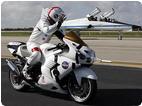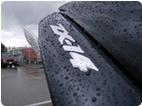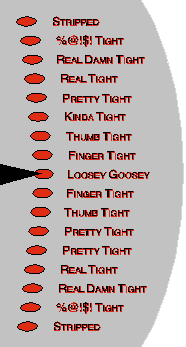I've never removed the front wheel from a bike. Can you point me to directions for that?
I found a tool kit spark plug tool was stamped to the size of the hex of the axle, that or tool-up as Grn has shown. I glued in some mm nut size so the walls wouldn't twist.
1. 15ftlbs for the lower pinch or axle bolts. Yeah, the lose one.
2. 22ftlbs for the lower crown pinch bolts. Alternate up to the final number.
3. 15ftlbs for the upper crown pinch bolts. Go back and double check all 10 bolts.
4. 25ftlbs for the calipers.
5. 94ftlbs for the axle.
6. Axle comes out right side. Loosen right lower pinchers only. Remove axle. The front is raised up where you can just drag the front wheel, axle slides out like butter or something is up [too high]. Clean and lube whole axle with grease and set aside on a paper towel. Threads need to be clean and not banged around at that end.
7. Caliper bolts are removed and the calipers are rocked back and forth until they cock out of the disc and rim or the pucks are not sunk deep enough. Hang calipers with bungee cords off the hand grips.
8. The plastic rings that hold the hoses in are a one hit wonder. Wonder if you should even bother with them? So this is where the front fender bolts are removed and you'll have to work the wheel out with a little finesse; lifting the front of the fender and roll the wheel out. Basically you are done.
9. The whole point to removing the wheel is to run that front axle back in and see how the forks line up? So before you grease it up, the axle is going to show you how only one fork needs to move up or down to line up the threads basically. Your index and thumb should spin that puppy in. The axle on the right side is sleeved some, so this is a guide more or less. The axle has to slide in as one into the left fork. The spin begins. So when the wheel is sent back in you are not fighting the fork, you are fighting a cocked wheel needing to be lined up more, that or the bike moved lower.
10. The axle is torqued, the calipers are on, the fender is bolted back on and tight; the axle pinchers are next; the caliper bolts are last. Two ways of watching the axle-to-fork fall into its own static setting. One would push down on the forks and let the legs spread in/out before the pinch. The other is to keep the wheel off the ground to spin. Slam on the brakes and let the discs to legs find their way, then set the axle pinch on the right fork. The caliper bolts were hand tight so they find their own float as well. The caliper bolts are the last to be torqued down.
Recap:
If you are going to go thru the motions set the fucker up then. No shop is going to take the time to go thru this kind of hand built setup. If you have a 'the touch,' meaning, twisted enough hardware in your time, you can tighten this bike with a hex handle set, the spark plug tool at the axle and all.
Tormenting the motorcycling community one post at a time
![]()













